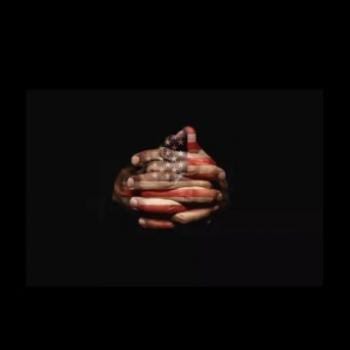When I have trouble picturing Jesus, I picture Mr. Rogers.
The challenge for me, when picturing Jesus, is the complicated relationship in my own mind between the Image and the images, the Word and the words, the Son of Man and the men I have known.
Mr. Rogers, though… Mr. Rogers just is. He is and was and ever shall be.
Like Jesus, there are those who have attempted to corrupt or twist his legacy. We have all heard the legends: sweaters worn to cover tattoos, 150 confirmed kills in Korea (too young) or Vietnam (too old). Then, for a brief time in the 90’s, maybe we heard Fox News pundits scapegoating him for the presumed self-centeredness and entitlement of Generation X. Finally, of course, there were the protestors at his funeral, waving signs reading “Fred Rogers in Hell,” because…well, even the Westboro Baptists were unclear on their own reasoning.
Despite the noise and innuendo, nothing sticks. The imago Rogers, cardigan and all, is indelible on our hearts and minds. When we think of Mr. Rogers we remember somebody loves me, just the way I am.
If nothing else, that is the message the viewer is left with after watching Won’t You Be My Neighbor, Morgan Neville’s documentary on the life and work of Fred McFeely Rogers, minister, musician, television producer, and the personality behind the long-running PBS children’s series Mr. Rogers’ Neighborhood. When we were children, Mr. Rogers told us that we were seen and valued as persons of inherent dignity. He taught us that our feelings, big or small, were real, human, and manageable. He told us that we are his neighbors, and he likes us just the way we are. What a simple message. How simple, and how radical.
Fred Rogers, like Jesus, was a radical. At a time when children’s entertainment was about imitating the fast-paced, competitive, even combative adult world, Mr. Rogers’ Neighborhood valued quietude and peace. The slow unfolding of a thought, shoes changed and tied in real time, or a turtle moving across a braided rug, nothing was too small to wonder at, or too huge to explain. Not divorce, not death, not war. In the documentary, a startling ad from 1968, in which an all-American GI tosses his M-16 through the television to a young boy, is juxtaposed against the first week of programming on Mr. Rogers’ Neighborhood, wherein helium balloons tagged with messages of peace and affirmation stop the escalation of King Friday’s war on change. Fred Rogers believed that the first step to peace, always, was humbly affirming the humanity of the self and the other.
It was a hot day in the Neighborhood when Mr. Rogers, soaking his feet in a child’s plastic wading pool, asked a passing police officer to join him. François Clemmons, the black actor and classical singer cast as Officer Clemmons, remembers this scene as an intentional reaction to an incident that was receiving news coverage at the time, where black children and youth were forced out of a public pool by white terrorists wielding bottles of muriatic acid. At the time, Clemmons (a self-proclaimed ‘ghetto boy’) voiced his hesitation to don the costume of a police officer, but for Rogers, it was vital that children of all races and ethnicities learned to recognize and trust the “helpers” in their communities. Still, this moment in the wading pool, two adult men washing the dust from their feet, taught more than that.
The image is striking, both in 1969 original and in the recreation the two men filmed thirty years later. A large, uniformed black man sits in a rickety folding chair next to an older white man, uniformed in a cardigan and sensible slacks (on another man they might be pants or trousers, on Fred Rogers they are most definitely slacks). The camera lingers unabashedly on their bare feet, brown and white, both pale and vulnerable in the water. Even as a child, I remember sensing the intimacy of the moment. I mean, how often does one see an adult man’s bare feet? They two men look into each other’s eyes and talk about the weather. They sing about the many ways they have of communicating love. The older man uses a towel to dry the feet of his friend.
Clemmons, now as old as Rogers was when they recreated the scene in 1999, is one of the most memorable personas in “Won’t You Be My Neighbor.” Still an outgoing, passionate artist, now an openly gay black man who speaks frankly of childhood poverty, the civil rights movement, and the AIDS epidemic, he seems to have little in common with Fred Rogers, twenty years older, white, born to privilege, a lifelong Republican and ordained Presbyterian minister. In the Neighborhood, however, what separates them is negligible. What unites them is love. Love that sees the whole person, believes deeply in their value, and wishes them nothing but good things: a place to rest, cold water on a hot day, a song about love.
It is impossible to look back on Mr. Rogers without pondering how he would respond to the world today. In its final act, Neville’s documentary reaches for an uplifting climax, but finds only scarce material from the last few years of Fred Rogers’ life. A colleague recalls the day he returned to film a PSA commemorating the one-year anniversary of 9/11. Rogers, she said, was tired and subdued. At one point he confided, “I just don’t see how this will make any difference.”
The man who had launched a career in television nearly forty years earlier died months later, an icon, but maybe not a trend-setter. The media, and the world rolled on.
“Am I a sheep?”
His widow, Joanne Rogers, remembers him asking this of her, soon after he received a diagnosis of terminal stomach cancer. He had spent days in the hospital already, quietly turning the pages of his Bible. “Oh, Fred,” she replied, “If anyone is a sheep, it’s you.”
Doubt, like all the other big and little feelings Mr. Rogers helped us understand, is human.
At the end of the day, I believe Mr. Rogers would understand why my heart cries to him first, not Jesus, when I need to remember that it is okay to feel scared, or hopeless, or doubtful, or sad.
After all, I am his neighbor, and he loves me. Just the way I am.
Theresa Marier Weiler is a Detroit-area musician and educator.













